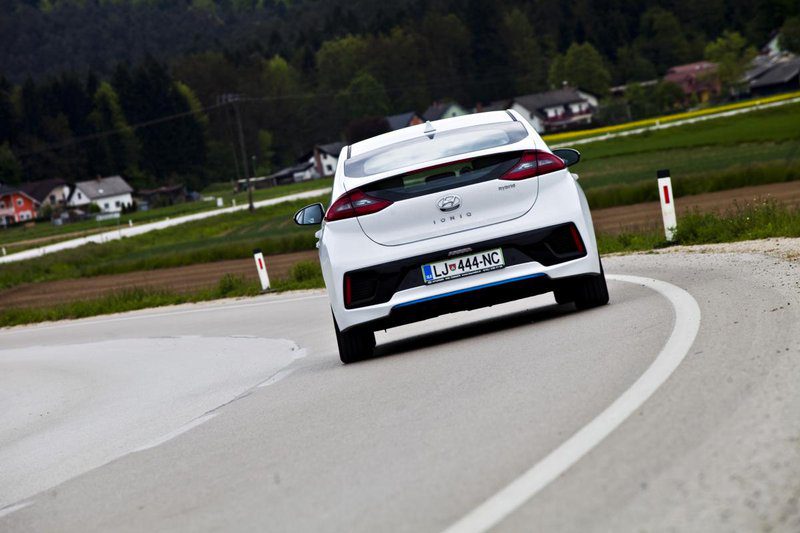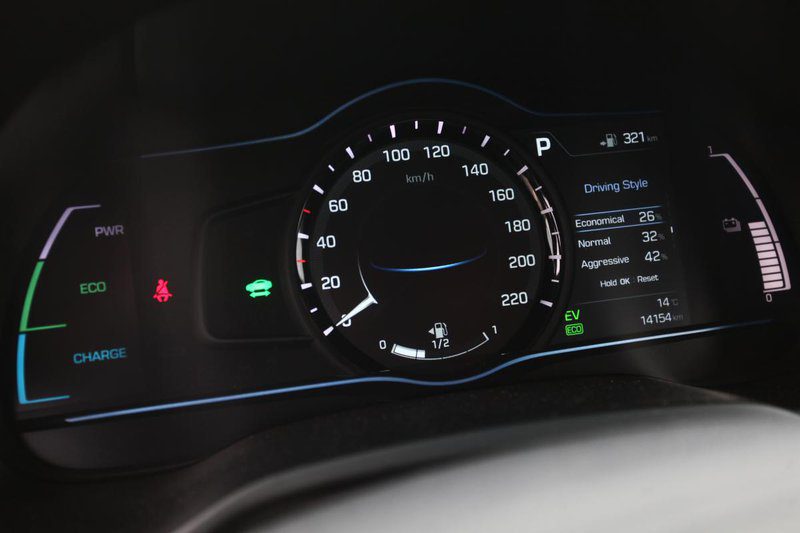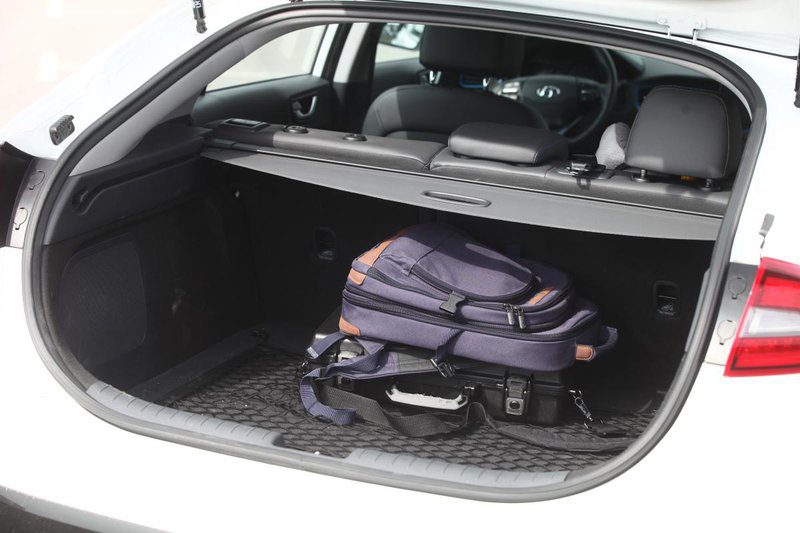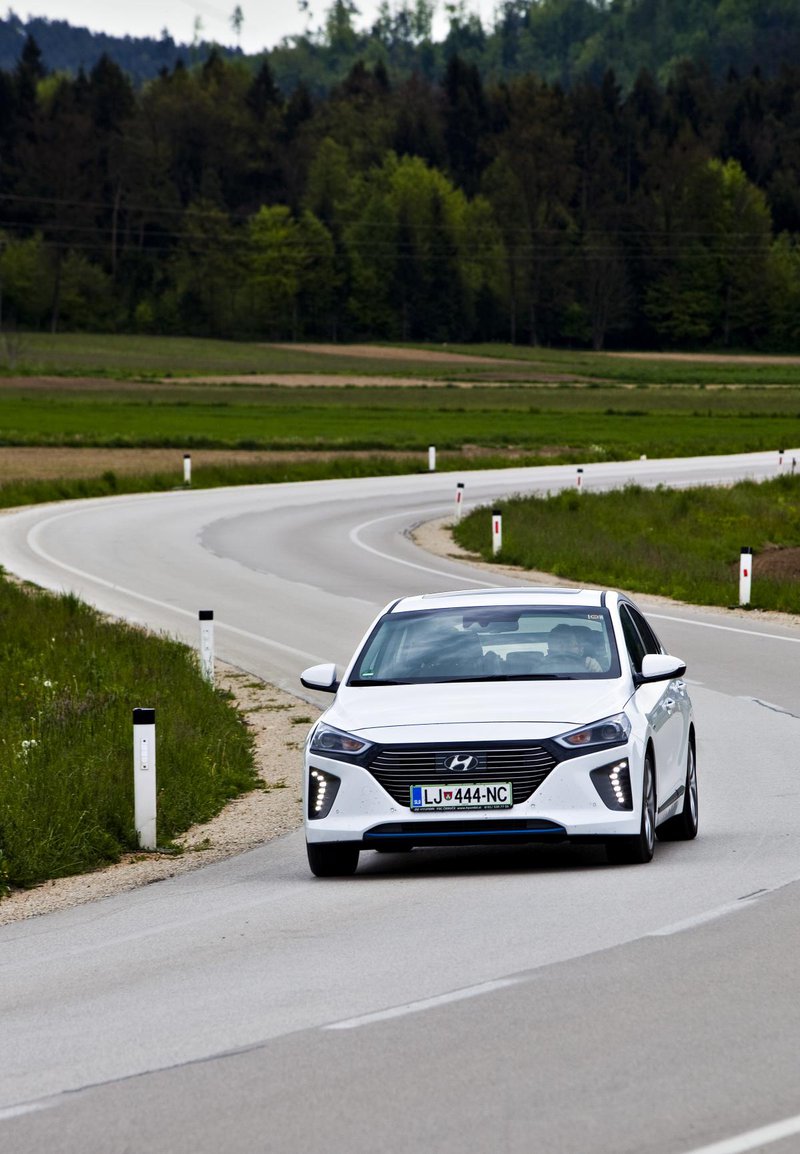
Test: Hyundai Ioniq hibrid Impression
Content
The Korean manufacturer wants to create a wide range of zero-emission vehicles that are projected to include 20 vehicles by the end of this decade, and the Ioniq (along with the ix35 fuel cell) is a first step in that direction.
The five-door Ioniq looks more like a "normal" car than its biggest competitor, the Toyota Prius. It has a very low air resistance coefficient (0,24), which only confirms that the designers and engineers did a good job. In addition, the car's weight has been reduced by using aluminum in addition to steel - an integral part of every eco-labelled car - for the hood, tailgate and some chassis parts.

Hyundai's progress is also reflected in the selected materials and finishes that characterize the vehicle's interior. Not quite, though, as some of the plastics used inside look a little cheap and overly sensitive, and the build quality was a little worse than you'd expect: the driver's seat was wobbly and the headrest wedged. But on the other hand, quite bright, at first glance, metal accessories that enliven the interior, and at first glance, a prestigious smooth surface.
The Ioniq dashboard looks like the dashboard of a traditional car (i.e. non-hybrid car) and gives the feeling that it has nothing to do with the futuristic experiments of some other brands. Such a design may turn off some enthusiasts, but on the other hand, it is obviously much more colorful on the skin of ordinary drivers, who are easily scared and even scared away from buying an overly futuristic and seemingly complicated interior. Also worth mentioning is a central color entertainment touchscreen and new gauges that are all-digital – all the information you need is presented to the driver on a high-resolution seven-inch LCD screen. Depending on the drive mode settings, the display also changes the way the data is presented.

Unfortunately, the infotainment system deserves its first drawback: its designers went too far in the pursuit of simplification, so we missed quite a few tuning options, but our biggest concern was that the system supports classic FM radio and digital DAB radio. as one source. In practice, this means that in the case of broadcasting a radio station in the FM and DAB bands, despite the preset FM version, it will always persistently switch to DAB, which is annoying in areas with poor signal (due to interruption of reception), and is especially embarrassing. which does this even if the station broadcasts Traffic Information (TA) on FM and not on DAB. In this case, the system first switches to DAB and then complains that there is no TA signal. Then the user has only two options: let the system find another station that has a TA, or turn off the TA itself. Competent.
Smartphone connectivity is exemplary, Apple CarPlay works as expected, and the Ioniq has a built-in system for wireless charging of compatible mobile phones.

The digital gauges are fairly transparent (because the Ioniq is a hybrid, we didn't miss the rev counter in normal or eco driving mode), but it's a pity the designers didn't use their flexibility better than they could. much more flexible and useful. Among them is the hybrid battery charge indicator, which has the same annoying feature as Toyota hybrids: its range is too wide and you won't see it showing a fully charged or fully discharged battery. Basically, it goes from one-third to two-thirds of the charge.
Ioniq equipment is mostly rich as it already has active cruise control, lane keep assist and dual-zone air conditioning with Style equipment, but when it comes to Impression equipment like the test Ioniq it means navigation, digital sensors, a system for blind spot control (works very well) with cross-traffic control, leather upholstery and heated and cooled front seats, bi-xenon headlights, improved sound system (Infinity), front and rear parking sensors with a reversing camera, etc. and more. In fact, the only surcharge for the test car that represents the pinnacle of the Ioniq hybrid offering was the glass sunroof.

Unfortunately, active cruise control is not the best, since it cannot stop and start on its own, but turns off at a speed of 10 kilometers per hour. Very sorry.
The driving feel is very good (the longitudinal movement of the driver's seat could have been a little more, but only those who are taller than 190 centimeters will notice this), the ergonomics are good (with the exception of the foot parking brake, the pedal of which is in shoes or ankle, you can easily hit with your foot and rub when entering) and even in the rear seats, passengers (if they are not too large) will not complain. Trunk? Shallow (due to the battery underneath), but still useful.
The hybrid Ioniq has a 1,6 horsepower 105-liter direct-injection petrol engine under the hood, assisted by a 32-kilowatt (44 horsepower) electric motor. It receives and stores energy in a lithium-ion battery with a capacity of 1,5 kilowatt-hours. The combination of both units (with a system output of 141 hp) and the six-speed dual clutch transmission is quite economical (typically 3,4 liters per 100 km) and at the same time quite active on the highway (albeit with 10,8 liters .-the second acceleration to 100 km / h is a little slower than in the electric model), but of course you can’t expect miracles only from the electric range or speed - we are already used to this in hybrids. It runs on electricity for only a mile or two and only at city speeds. If you want more, you will need to cut back on your electric Ioniqu. Interestingly, in the test, the green EV sign, which indicates electric-only driving, was sometimes lit for a few seconds after the petrol engine had already been started, or started before it went out.

On our standard lap, the Ioniq performed at exactly the same mileage as a Toyota Prius, which of course doesn't mean it's as economical as the age of the hybrids. What the average driver consumes depends on where they use the car the most. Testing has shown that the Ioniq feels less comfortable in the city, where the fact that it has a six-speed dual-clutch transmission means the engine runs in a sub-optimal range for long periods of time and delivers higher fuel consumption. On the other hand, it's great on the track, where such a gearbox is much less likely to start the engine at high speeds than CVT hybrids, the speeds are usually less, and the assistance of the electric motor is more. That's why the Ioniq is a much more down-to-earth car on the highway and reduces fuel consumption.
It's worth noting that, as you'd expect, the Ioniq's lower RPM motor (where it sometimes only runs to charge the battery) was quite rough and the sound was not very pleasant. Fortunately, since it's well-soundproofed and is still off most of the time, you don't listen to it enough to disturb it.

The transmission is excellent and its performance is barely noticeable, whether in normal driving mode or in Sport or Eco driving modes, while in Sport mode the transmission shifts up to a higher gear at higher revs, and in Eco mode it constantly downshifts gears to the lowest. ... possible fuel consumption on the fly. As usual with hybrids, the regenerative braking system charges the battery, and for this the Ioniq has a dedicated display showing the regeneration power. With some foresight and attention (at least at the beginning, until the driver of the car is used to it), the battery can be safely kept full, which means that rather long urban sections can be transported on electricity. The gasoline engine shuts down at 120 kilometers per hour when the gas is removed, and if the load is light enough, the Ioniq can only run on electricity at these speeds.
Unlike the electric Ioniq, which has to settle for a semi-rigid rear axle due to its larger battery, the Ioniq Hybrid has a multi-link rear axle. On poor Slovenian roads, this is noticeable (especially around corners), but overall the Ioniq has good maneuverability, with enough steering wheel feedback and suspension stiff enough not to wobble like a ship, while still providing a fairly high level of comfort. Hyundai engineers did a good job here.
And we can also write this for the hybrid Ioniq in general: a job well done in the direction they set for the Ioniq at Hyundai; so create a true, custom-built hybrid from the start that feels closer to classic cars while driving. Until now, we have lacked such machines. A good group of customers want enough environmentally friendly cars, but they don't like the "space" look and some of the trade-offs required by the pursuit of the lowest possible consumption and emissions. And just under 23 thousandths of the base price and just under 29 for the most equipped version means you won't have to grind your teeth over the price.
text: Dušan Lukič · photo: Саша Капетанович

Hyundai Loniq Hibrid Impression
Basic data
| Sales: | Hyundai Auto Trade Ltd. |
|---|---|
| Base model price: | € 28.490 XNUMX € |
| Test model cost: | 29.540 € |
| Power: | 103,6kW (141 KM) |
| Acceleration (0-100 km / h): | 10,8 with |
| Maximum speed: | 185 km / h |
| Mixed flow ECE: | 3,9l / 100km |
| Guarantee: | 12-year general warranty with no mileage limit, XNUMX-year anti-rust warranty. |
| Systematic review | 15.000 miles or one year. km |
Cost (up to 100.000 km or five years)
| Regular services, works, materials: | 786 € |
|---|---|
| Fuel: | 4.895 € |
| Tires (1) | 1.284 € |
| Loss of value (within 5 years): | 9.186 € |
| Compulsory insurance: | 3.480 € |
| CASCO INSURANCE (+ B, K), AO, AO + | 5.735 ( |
| Calculate the cost of auto insurance | |
| Buy up | € 25.366 0,25 (km cost: XNUMX €) |
Technical information
| engine: | Engine: 4-cylinder - 4-stroke - in-line - petrol - transversely mounted at the front - bore and stroke 72 × 97 mm - displacement 1.580 cm3 - compression 13,0:1 - maximum power 77,2 kW (105 hp) .) at 5.700 rpm - average piston speed at maximum power 18,4 m / s - specific power 48,9 kW / l (66,5 hp / l) - maximum torque 147 Nm at 4.000 rpm min - 2 camshafts in the head belt) - 4 valves per cylinder - direct fuel injection. Electric motor: maximum power 32 kW (43,5 hp), maximum torque 170 Nm. System: Maximum power 103,6 kW (141 PS), maximum torque 265 Nm. Battery: Li-ion polymer, 1,56 kWh |
|---|---|
| Energy transfer: | engine drives the front wheels - 6-speed dual clutch transmission - np ratio - np differential - 7,5 J × 17 rims - 225/45 R 17 W tires, rolling range 1,91 m. |
| Capacity: | top speed 185 km/h - acceleration 0-100 km/h 10,8 s - average combined fuel consumption (ECE) 3,9 l/100 km, CO2 emissions 92 g/km - electric range (ECE) np |
| Transportation and suspension: | limousine - 5 doors, 5 seats - self-supporting body - front single suspension, coil springs, three-spoke wishbones, stabilizer bar - rear multi-link axle, coil springs, stabilizer bar - front disc brakes (forced cooling), rear disc brakes, ABS, rear electric parking brake wheels (switch between seats) - steering wheel with a gear rack, electric power steering, 2,6 turns between extreme points. |
| Mass: | empty vehicle 1.445 kg - permissible total weight 1.870 kg - permissible trailer weight with brake: 1.300 kg, without brake: 600 kg - permissible roof load: 100 kg. |
| External dimensions: | length 4.470 mm – width 1.820 mm, with mirrors 2.050 1.450 mm – height 2.700 mm – wheelbase 1.555 mm – track front 1.569 mm – rear 10,6 mm – ground clearance XNUMX m. |
| Inner dimensions: | longitudinal front 870-1.100 mm, rear 630-860 mm - front width 1.490 mm, rear 1.480 mm - head height front 880-940 mm, rear 910 mm - front seat length 500 mm, rear seat 480 mm - luggage compartment 443 - 1.505 365 l – handlebar diameter 45 mm – fuel tank XNUMX l. |
Our measurements
| T = 15 ° C / p = 1.028 mbar / rel. vl. = 55% / Tires: Michelin Primacy 3/225 R 45 W / odometer status: 17 km | |
| Acceleration 0-100km: | 10,6s |
|---|---|
| 402m from the city: | 17,5 years ( 131 km / h) |
| test consumption: | 5,4 l / 100km |
| Fuel consumption according to the standard scheme: | 3,9 l / 100km |
| Noise at 90 km / h in 6rd gear | 60dB |
| Noise at 130 km / h in 6rd gear | 63dB |
Overall rating (340/420)
Hyundai has proven with the Ioniq that it knows how to deal with alternative drive vehicles. We can't wait to put the electric and plug-in hybrid to the test
Exterior (14/15)
The Huyundai Ioniqu has a design that stands out without being annoying with its environmental friendliness.
Interior (99/140)
As we are used to in hybrids: the trunk requires compromises due to the battery. The rest of the Ioniq is great.
Engine, transmission (55
/ 40)A hybrid transmission with a dual-clutch transmission is less efficient but smoother and quieter than a continuously variable transmission.
Driving performance (58
/ 95)The Ioniq is not an athlete, but the ride is pleasant and comfortable enough.
Performance (26/35)
Of course, the Ioniq is not a race car, but it is powerful enough to easily follow the flow of (even fast) traffic.
Security (37/45)
Points were earned by five NCAP stars for test accidents and electronic safety assistants.
Economy (51/50)
The price is quite acceptable for a hybrid, and the low consumption also brings points.
We praise and reproach
radio control (Fm and DaB)
parking brake installation
shallow trunk
